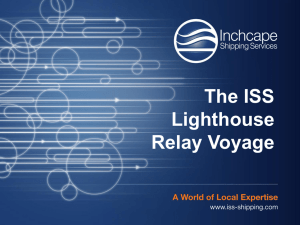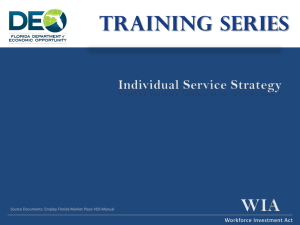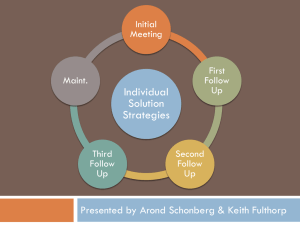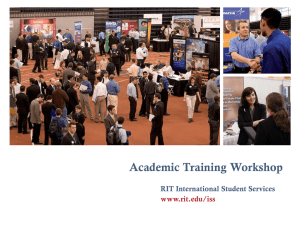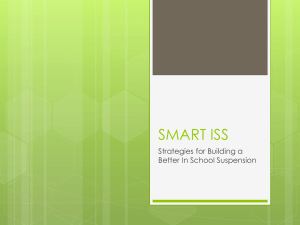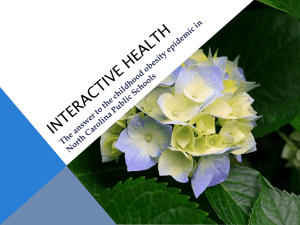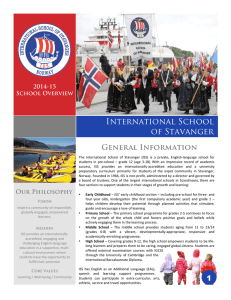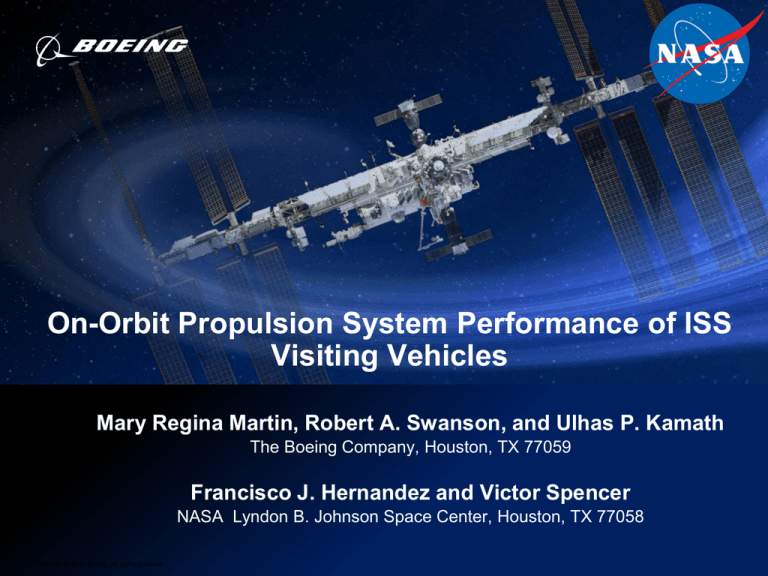
On-Orbit Propulsion System Performance of ISS
Visiting Vehicles
Mary Regina Martin, Robert A. Swanson, and Ulhas P. Kamath
The Boeing Company, Houston, TX 77059
Francisco J. Hernandez and Victor Spencer
NASA Lyndon B. Johnson Space Center, Houston, TX 77058
Copyright © 2010 Boeing. All rights reserved.
Overview
• Abstract
• ISS Visiting Vehicles
• Propulsion System Requirements and Priorities
• Hazard Control
• Design Drivers for Pressure Systems
• Integration and Operations
• Conclusion
• Sources
2
Abstract
• ISS represents the culmination of over two decades of unprecedented
global human endeavors to conceive, design, build and operate a
research laboratory in space.
• Uninterrupted human presence in space has been made possible by
an international fleet of space vehicles facilitating crew rotation,
delivery of science experiments and replenishment of propellants
and supplies.
• On-orbit propulsion systems on both ISS and Visiting Vehicles are
essential to the continuous operation of the ISS.
• This paper compares the ISS visiting vehicle propulsion systems by
providing an overview of key design drivers, operational considerations
and performance characteristics.
• Despite their differences in design, functionality, and purpose, all visiting
vehicles must adhere to a common set of interface requirements along with
safety and operational requirements.
• This paper addresses a wide variety of methods for satisfying these
requirements and mitigating credible hazards anticipated during the on-orbit
life of propulsion systems, as well as the seamless integration necessary for
the continued operation of the ISS.
3
ISS Visiting Vehicles
Visiting Vehicles provide the ISS with its necessary
lifeblood of cargo and consumables, including
propellants.
• 7 sets of Visiting Vehicles to date:
• Soyuz
• Space Shuttle Orbiters
• Progress
• ATV
• HTV
• Dragon
• Future Vehicles
• Cygnus (scheduled to fly Summer 2013)
• Commercial Crew vehicles (~2017)
4
ISS Visiting Vehicles
ISS Visiting Vehicle Flights
200
Soyuz Missions (34)
Mated Mission Length, Days
Shuttle Missions (37)
150
Progress Missions (49)
ATV Missions (3)
HTV Missions (3)
Dragon Missions (3)
100
50
0
11/1/1998
7/28/2001
4/23/2004
1/18/2007
Date
10/14/2009
7/10/2012
5
Soyuz
• Primary (current) crew vehicle
flying to the ISS.
• Can provide propulsive
control to ISS in off-nominal
cases
• Docks autonomously using its
own propulsion system
• Flown 34 ISS Missions
• Propellant: UDMH and NTO,
Hydrogen Peroxide (DMPS)
• Pressurants: Helium, Nitrogen
6
Orbiter (Space Shuttle)
• Primary US crew
vehicle until retired
• Provided propulsive
support during mated
missions
• Docked autonomously
using its own
propulsion system
• Flown 37 ISS Missions
• Propellant (OMS and
RCS): MMH and NTO
• Pressurant: Helium
7
Progress
• Primary current cargo vehicle
• Provides propellant refueling support
• Provides propulsive support, including primary ISS roll
control capability until docking of the MLM
• Docked autonomously using its own propulsion system
• Flown 49 ISS Missions
• Propellant: UDMH and NTO
• Pressurant: Helium (CPS)
and Nitrogen(RFS)
8
Automated Transfer Vehicle (ATV)
• High capacity cargo vehicle
• Provides propellant resupply support
• Provides propulsive support
• Docked autonomously using its own propulsion system
• Flown 3 ISS Missions
• Propellant: MMH (PRSS), UDMH (RFS), and NTO
• Pressurant: Helium
9
H-II Transfer Vehicle (HTV)
• Large capacity cargo
vehicle
• Mates to the ISS Node
2 port via a capture
and berthing method
• Flown 3 ISS Missions
• Propellant: MMH and
MON3
• Pressurant: Helium
10
Dragon
• Commercially-developed
US cargo vehicle
• Mates to the ISS Node 2
port via a capture and
berthing method
• Only current returnable
cargo vehicle
• Flown 3 ISS Missions
• Propellant: MMH and
NTO
• Pressurant: Helium
11
Cygnus
• Commerciallydeveloped US cargo
vehicle
• Mates to the ISS
Node 2 port via a
capture and berthing
method
• 1st ISS Mission
scheduled for
Summer 2013
• Propellant:
Hydrazine and NTO
• Pressurant: Helium
12
Future Vehicles
• Future commercial crew vehicles are under
development under the Commercial Crew
Integrated Capacity (CCiCAP) contract and
Certification Product Contract (CPC).
13
ISS Visiting Vehicle Ports
14
Visiting Vehicle Priorities
1.Crew Safety
2. ISS safety
3. Protection of ISS lifetime
4. Protection of ISS docking and berthing
capability
5. Visiting Vehicle safety
6. Mission success
15
Propulsion System Requirements
• Design and Operations driven by:
•
•
•
•
•
Safety of crew and ISS structure
ISS Program requirements and constraints
International agreements
Mission goals
Visiting Vehicle intended purpose
• All Visiting Vehicles must meet:
•
•
•
•
Safety Requirements Document (SRD)
Interface Requirements Documents (IRDs)
Segment Specifications
All ISS Flight Rules
16
Sample Propulsion System Design
17
Hazard Control
• Hazard Control – the use of design and
operational measure to reduce the likelihood of
hazardous effects
• Hazard Control includes:
•
•
•
•
•
•
•
•
Hazard Elimination
Damage Control
Containment
Isolation of potential hazards
Failure tolerance considerations
Incorporation of safety devices
Crew operational procedures
Protective clothing and equipment
18
Hazard Control
• Most common propulsion system hazards:
• Collision
• Contamination
• Explosion
• Two categories of hazards:
• Catastrophic – hazard resulting in disabling or fatal
crew injury, or loss of ISS or Orbiter
• Critical – hazard resulting in non-disabling crew
injury, severe occupational illness, loss of a major ISS
life-sustaining element, or damage to the Orbiter or
ground facility
19
Hazard Control
• Methods of meeting safety requirements:
•
•
•
•
Fault tolerance (preferred and sometimes mandated)
Design for minimum risk (DFMR)
Isolation, Independent Inhibits
Operational control
• Fault Tolerance:
• Catastrophic Hazards: require two fault tolerance or
three independent inhibits
• Critical hazard: require single fault tolerance or two
independent inhibits
20
Design Drivers for Pressure Systems
• Water Hammer/Surge Pressure
• Maximum Design Pressure (MDP)
• Highest pressure driven by maximum pressures of propulsion
system components, maximum temperature, and transient
temperature excursions
• Accommodates two worst case failures
• Maximum Expected Operating Pressure (MEOP)
• Maximum pressure at which system operates in nominal
conditions.
• MDP must have sufficient margin above MEOP
• Over-Pressurization Protections
• Primary Regulator Set Point
21
Pressure System Parameters
22
NTO Tank Over-Pressurization Potential
23
Integration and Operations – Flight Rules
• Flight rules:
• Developed in a joint effort by MOD, ISS engineering
specialists, and vehicle owners
• Integrate relevant engineering constraints
• Outline procedures for nominal mission operations
• Assign responsibility and authority
• Plan a course of action for potential contingencies
and anomalies
24
Propellant Quantity Gauging
• 4 primary propellant quantity gauging methods
• PVT method
• Uses ideal gas law
PV = nRT
• BTI method
•
•
•
•
•
•
m = consumption in kg
m = F * Ton/Isp
F = thrust in kgf
F = (K1 * Pavg) + K2
Ton = total on-time in seconds
Isp = specific impulse
Pavg = the average pressure of all tanks feeding the thruster in kg/cm2
K1 and K2 = constants derived from the acceptance test data for each
type of thruster
• Radio frequency method
• Physical measuring device utilizing properties of diaphragm tanks
25
Integration and Operations
•
•
•
•
•
•
•
•
•
•
•
•
System priming
Flight in regulated vs blowdown mode
Thruster failure detection and reaction
Docking vs Capture and Berthing
Thruster inhibits during docked or berthed phase
Propulsive support – attitude control and translation
Russian Control
USTO
Loads and structural concerns
Propellant resupply
ISS atmosphere contamination
Abort capability
26
ISS Propulsive Support
• Commanded by Service Module computers
• 2 modes:
• Russian Segment Motion Control System (RS MCS)
• US – Thrusters Only (USTO)
• Roll Attitude Control
• Service Module
• Progress at DC-1 Nadir or MRM2 Zenith
• MLM (scheduled for launch in Dec 2013)
• Pitch/Yaw Attitude Control
• Service Module
• Progress at SM-Aft
• ATV at SM-Aft
27
ISS Propulsive Support
• Significant portion of ISS thruster control is
dedicated to translational control (mostly
reboosts)
• Translational control
•
•
•
•
Progress R&D thrusters at SM-Aft
ATV thrusters (OCS or ACS) at SM-Aft
SM Main Engines
Progress Mid-Ring thrusters at DC-1 Nadir
(ΔV ≤ 0.7 m/s only)
28
ISS Mean Altitude vs. Accumulated ΔV
29
ISS Altitude vs. Yearly Propellant Consumption
30
ISS Refueling Support
• ISS Total On-Orbit Propellant Capacity = 7460 kg
• Maximum Propellant Capacity of FGB = 6600 kg
• Maximum Propellant Capacity of SM = 860 kg
• Total Propellant consumed over ISS Program:
nearly 80,000 kg
• Propellant provided by Visiting Vehicles:
~75,000 kg
31
ISS Propellant Load vs. Yearly Prop Consumption
32
ISS Accumulated Propellant Consumption
33
ISS Contamination
• General crew or atmosphere contamination risks
are relatively minor except during EVAs
• EVA contamination risks:
• Fuel and Oxidizer Reaction Product (FORP)
• Gross propellant leakage
• Contamination deposited on a spacesuit
• Protections in place:
•
•
•
•
•
Keep Out Zones (KOZ) in vicinity of thrusters
Procedures to wipe down suits during EVA
Procedures to clean suits after EVA
Procedure to eliminate contamination in airlock
Vehicles must show maximum undetectable propellant leakage is < 150
grams/hour
• Thruster inhibits request for crew to enter KOZ
• Some workarounds available if minimum # of inhibits is not possible
• Pressure decay leak checks performed prior to capture & berthing, e.g.,
HTV.
34
Abort Capability
• Abort capability necessary to protect against
propulsion system failure or malfunction:
• Unsafe trajectory
• Loss of pressurization during regulated mode
• Thrusters failures
• Delay in departure burn
• Loss of critical systems (typically requires
multiple losses)
35
Conclusion
• Visiting Vehicles are necessary for continued operation of the ISS.
• Each Visiting Vehicle is able to meet all the ISS safety and mission
requirements through their unique vehicle design.
• Sufficient margins are built into their design to account for worstcase on-orbit conditions.
• VVs have provided the bulk of the total ISS propellant consumed since
the FGB was launched in 1998 with a total of ~70,000 kg
• Using the requirements laid out in the SRD, IRD, and the flight rules,
the ISS Program has successfully docked or berthed visiting vehicles
over one hundred and twenty times throughout the fourteen years of its
life.
• United effort on part of all international and commercial partners in
design and operation of visiting vehicles is vital to the continued
operation of the ISS.
36
Sources
1. Beisner, M., Kamath, U.P., Swanson, R.A., “HTV Propulsion Systems Databook”, The Boeing Company,
Publication No. D684-13625-01 Rev A, Houston, TX, Mar. 2011. Cincinnati, OH, July 2007.
2. Cross, A., Duffin, S., and Greenberg, Z. “Transient Surge Pressure Characterization of a Spacecraft Propulsion
Subsystem due to Propellant Priming and Thruster Valve Cycling”, JANNAF, JANNAF 2012-0001I, San Antonio,
TX, May 2012.
3.
“Interface
Definition Document (IDD) for International Space Station (ISS) Visiting Vehicles (VVs)”, NASA, SSP
50235, Houston, TX, Feb. 2000.
4. “International Space Station (ISS) to Commercial Orbital Transportation Services (COTS) Interface Requirements
Document (IRD)”, NASA, SSP 50808, Houston, TX, July 2007.
5. Karakulko, W., Russell, S., Sanders, G.B., Spencer, V., “Russian Propulsion and Propellant Resupply Systems for
the ISS”, NASA, JSC-27979 Rev. F, Houston, TX, Mar. 2010.
6. Kamath, U., Metrocavage, K., Russell, S., Spencer, V., Swanson, R.A., “On-Orbit Propulsion and Methods of
Momentum Management for the International Space Station”, AIAA, AIAA 2009-4899, Denver, CO, Aug. 2009.
7. Kamath, U.P., Krajchovich, M.C., Swanson, R.A., “ATV Propulsion and Propellant Resupply Systems Databook”,
The Boeing Company, Publication No. D684-13250-01, Houston, TX, Jan. 2009.
8. Keyser, L., “Apollo Experience Report – the Role of Flight Mission Rules in Mission Preparation and Conduct”,
NASA TN D-7822, Houston, TX, Nov. 1974.
9. Pedley, M.D., Internal Note to NASA EVA Project Office, “Propellant Contamination Issues – Potential Hazards to
Crew”, NASA, Houston, TX, Feb. 2001.
10.“Safety Requirements Document”, NASA, SSP 50021 DCN 004, Houston, TX, July 2009.
11.“Space Systems – Composite Overwrapped Pressure Vessels (COPVs)”, ANSI/AIAA, S-081A-2006, Reston, VA,
July 2006.
12.Yamamoto, M., Nakai, S., Ishizaki, S., Matsuo, S., Imada, T., Russell, S., and Kamath, U.,“Surge Pressure
Management in HTV Propulsion System,” 43rd AIAA/ASME/SAE/ASEE Joint Propulsion Conference & Exhibit,
“Structural Design and Verification Requirements”, NASA, SSP 30559 Rev D, Houston, TX, July 2007.
37


